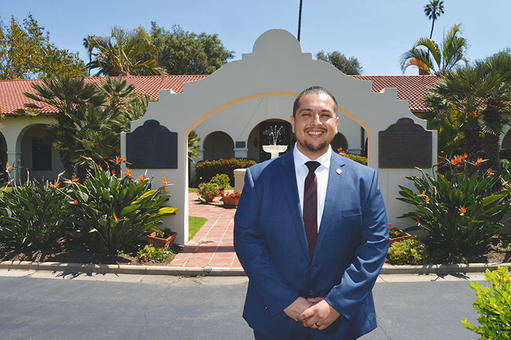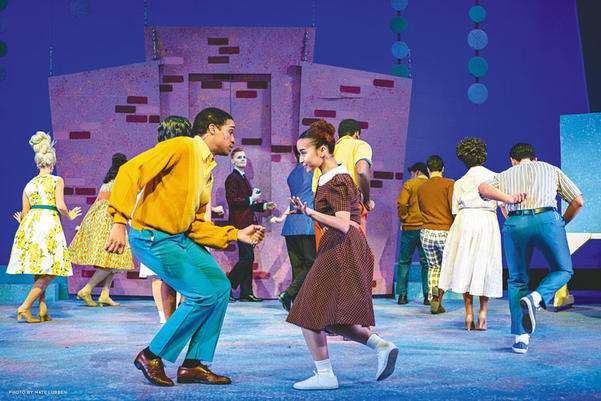The City of Carson is home to a variety of cultural and arts institutions, including historic sites, museums, a major university, and a community center with various recreational and support programs.
Carson is one of 11 South Bay cities that was originally part of Rancho San Pedro, the first Spanish land grant in California. Manuel Dominguez, grandson of grant recipient Juan Jose Dominguez, eventually became mayor of what was then known as El Pueblo de Los Angeles. He later resided with his six daughters at the Dominguez Rancho Adobe, which is now a historic site and museum. His descendants – the Carson, Watson and Del Amo families – are still involved with the site today, according to Executive Director Luis Fernandez.

Luis Fernandez came on as executive director at the Dominguez Rancho Adobe Museum about six months ago. The museum features displays of artifacts from the Dominguez family, which was gifted the entirety of the South Bay via a Spanish land grant in 1784. (Photograph by the Business Journal’s Larry Duncan)
“The museum was opened to the public in 2004,” Fernandez said. “The mission statement of the Friends of Rancho San Pedro, which is the funding arm of the museum, is to preserve and increase community awareness of the Dominguez family and the homestead and the Rancho San Pedro, which is the first land grant in California.”
The nonprofit museum, located near Carson in Rancho Dominguez, is open to the general public via scheduled tours between 1-4 p.m. on Wednesdays, Saturdays and Sundays. Third and fourth grade students from regional public schools regularly visit to learn about the site and its history in Southern California.
“Throughout the tour, you would actually learn more about the Dominguez family, the legacy of the South Bay and the political history as well,” Fernandez said. “So we have artifacts here, paintings [and] photographs from the family.” The original structure on-site was built in 1826, he noted. The facility is available for rental for events.
Another local museum, the International Printing Museum, also places an emphasis on education. The museum houses a working collection of antique and replica printing presses and machinery. Originally founded in 1988 in Buena Park, the museum relocated to Carson in 1998.
“The collection probably represents 300 years of machines and artifacts,” Executive Director Mark Barbour said. “The oldest physical printing press [in the collection] is from 1806.” This printing press is the same kind that Benjamin Franklin – who spent a portion of his life working as a printer – would have used, he noted.
The museum is open to the general public on Saturdays from 10 a.m. to 4 p.m. During the week, it hosts group tours, including many from local schools. “One of the delightful parts about that museum is that it is a working collection,” Barbour said. “We are able to use the machines to demonstrate the process of printing and print keepsakes and historical documents to . . . help in our process of storytelling about American and world history, great inventions and inventors [like] Benjamin Franklin, Guttenberg and others like that, and the advance of the printing press across the states in the 19th century.”
The International Printing Museum has a mobile trailer modeled after a Benjamin Franklin-era printing shop that visits schools and groups throughout California and Arizona, Barbour noted. The museum itself is in the midst of expanding its galleries, which currently encompass about 18,000 square feet.
When it comes to the arts, California State University, Dominguez Hills (CSUDH) offers year-round performances and programming open to the surrounding community.
The university’s theater and dance programs produce two plays and two dance concerts each year at the University Theatre on campus, which seats about 500 people, according to Bill DeLuca, professor of theater arts. Smaller productions are also mounted in the Edison Studio Theatre, which seats about 65 people.
Last year, the theater department partnered with the City of Carson to produce the large-scale musical “Hairspray” in addition to its regular lineup of productions. For years, the department had been considering putting on a popular musical as a means of public relations outreach and recruiting, DeLuca said. To assist in this effort, the city awarded the university an $18,000 grant. The grant enabled the university to hire professional musicians to play during the performance, as well as professional actors to supplement the cast of students.
DeLuca leads Teatro Dominguez, a theater group within the department that, through an academic course, visits local schools to provide educational performances. “It’s multicultural children’s theater,” DeLuca said. “A lot of the things we do with Teatro are historical kinds of plays.” Last year, the group visited schools to put on a play about the Dominguez family and the origins of the South Bay. “That was a nice historical play that we toured to 4th grade classes,” he said.
CSUDH also houses an art gallery that is open to the public. “The University Art Gallery is one of the major exhibition spaces in the South Bay, and it is a valuable resource for the campus and surrounding community,” Director Kathy Zimmerer told the Business Journal via e-mail. “We are dedicated to serving our campus and local community by exploring art and culture in all its diversity through our exhibitions and events.”

The California State University, Dominguez Hills Theatre & Dance Department mounted a production “Hairspray,” a popular musical with a large cast, last fall. The production was made possible by a grant from the City of Carson. (Photograph by Nate Lubben)
The University Art Gallery also works with local groups. “We have worked closely for years with the Boys and Girls Club of Carson to create K-12 Arts in the Schools workshops, including a series of workshops in conjunction with two exhibits last year, ‘Inciteful Clay’ and ‘Wild Land,’” Zimmerer wrote.
The gallery features between seven and 10 exhibitions per year, including two annual exhibitions by CSUDH seniors, according to Zimmerer. It also hosts visiting exhibitions. “We recently hosted the exhibit ‘Heated Exchange: Contemporary Encaustic,’ which featured 10 artists who use the ancient art of encaustic (hot wax) to create their paintings and sculpture,” Zimmerer said. “This exhibition was organized by Virginia Commonwealth University, with artist Reni Gower as curator.”
Upcoming exhibitions include a showcase of works by 16 CSUDH design program graduates, which is showing on April 13 from 5:30-7:30 p.m., and the annual senior studio art exhibition, which runs April 24-May 4.
One of the city’s largest hubs for community events and programming is the Carson Center, a municipal facility with 40,000 square feet of event space. “Primarily the Carson Center is a banquet/convention center type facility for bookings for the public,” Community Center Manager Adrian Reynosa said. The Carson Center offers 23 bookable spaces for weddings, small conventions and other events, including a ballroom capable of seating up to 800 people.
The center also houses various community programs sponsored by the city, including a Dial-A-Lift transportation program, a stroke center to help stroke victims rehabilitate and an early childhood development program. “We also have our career center housed here at the facility, where the public can come in and get information on jobs, resume critiques [and] interview workshops. They also provide a variety of job fairs throughout the year here at the site as well for the public to help them gain jobs and employment.”
Cal State Dominguez Hills: A Community Resource
California State University, Dominguez Hills is a growing institution within the CSU system and stands to contribute to Carson, not only through its existing academic programs but also through future development.
The university is working on a campus master plan to carry it through the next two decades and beyond, according to Naomi Goodwin, interim vice president of administration and finance. “The focus is on setting the stage for the next 20-plus years for life at the campus and really envisioning the future buildings and facilities that we need to support our academic mission,” she said.
“We are looking to create a university village on the east side of campus that would expand the campus as a living/learning community,” Goodwin said. “It would be a blend of residential, pedestrian-oriented retail and then open spaces for meeting and entertainment, as well as business development,” she explained.
Residences would include student residence halls, faculty housing and market rate units for anyone wishing to live on campus, according to Goodwin. The development would generate funding for the university.
The plan also addresses needs associated with academic facilities. “Dominguez Hills is a really vibrant and energetic sort of campus community,” Goodwin said. “Unfortunately, though, all of our academic buildings were built in the late 1960s and ’70s, including the current science building which was built in 1973.”
The university received a $4 million grant from Toyota to create the Toyota Center for Innovation in STEM Education within a planned $82 million science building. “It’s designed to provide cutting-edge instruction for our own students who are in the science disciplines but then also to help teacher candidates . . . in terms of learning how to teach science,” Goodwin explained.
This fall, the university had 14,731 students enrolled, according to Dr. Rod Hay, provost and interim vice president of academic affairs. Of those, 10,862 were full-time students. “This is my 21st year, and we just continue to grow our reputation and the number of applications pretty significantly,” Hay said. About 55% of CSUDH students say they work more than part-time in addition to pursuing their degrees, he noted.
The student body is diverse, with 60.3% of students identifying as Hispanic, 14.5% as African American, 10.9% as white, 10.8% as Asian, 0.3% as Hawaiian-Pacific Islander, 0.1% as American-Indian, and 3.1% as two or more races.
“This CSU is such a resource for the surrounding community. A large percentage of our alums still live within this area,” Hay said. “Basically, they are coming [here], being educated and then going back into the community and taking positions. So I think we are an incredibly good resource for the region.”
